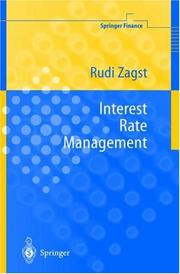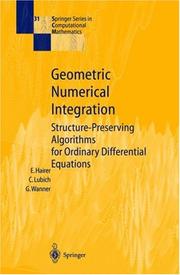| Listing 1 - 10 of 10 |
Sort by
|

ISBN: 0387952241 1441929142 1475736878 9780387952246 Year: 2002 Publisher: New York, N.Y. Springer
Abstract | Keywords | Export | Availability | Bookmark
 Loading...
Loading...Choose an application
- Reference Manager
- EndNote
- RefWorks (Direct export to RefWorks)
The unifying approach of functional analysis is to view functions as points in some abstract vector space and the differential and integral operators relating these points as linear transformations on these spaces. The author presents the basics of functional analysis with attention paid to both expository style and technical detail, while getting to interesting results as quickly as possible. The book is accessible to students who have completed first courses in linear algebra and real analysis. Topics are developed in their historical context, with accounts of the past - including biographies - appearing throughout the text. The book offers suggestions and references for further study, and many exercises. Karen Saxe is Associate Professor of Mathematics at Macalester College in St. Paul, Minnesota. She received her Ph.D. from the University of Oregon. Before joining the faculty at Macalester, she held a two-year FIPSE post-doctoral position at St. Olaf College in Northfield, Minnesota. She currently serves on the editorial board of the MAA's College Mathematics Journal. This is her first book.
Functional analysis --- Functional analysis. --- Mathematical analysis. --- Analysis (Mathematics). --- Analysis. --- 517.1 Mathematical analysis --- Mathematical analysis

ISBN: 0817667911 3764367911 3034894805 3034882211 9783764367916 Year: 2002 Volume: 50 Publisher: Basel: Birkhäuser,
Abstract | Keywords | Export | Availability | Bookmark
 Loading...
Loading...Choose an application
- Reference Manager
- EndNote
- RefWorks (Direct export to RefWorks)
Evolution equations. --- Differential equations, Partial. --- Semigroups. --- Functional analysis. --- Evolution equations --- Differential equations, Partial --- Semigroups --- Functional analysis --- Mathematical analysis. --- Analysis (Mathematics). --- Analysis. --- 517.1 Mathematical analysis --- Mathematical analysis

ISBN: 0521813727 0521890675 Year: 2002 Publisher: Cambridge Cambridge University press
Abstract | Keywords | Export | Availability | Bookmark
 Loading...
Loading...Choose an application
- Reference Manager
- EndNote
- RefWorks (Direct export to RefWorks)
Mathematical analysis. --- 517 --- 51-74 --- 517 Analysis --- Analysis --- 51-74 Mathematics--?-74 --- Mathematics--?-74 --- Mathematical analysis --- 517.1 Mathematical analysis --- 517.1. --- 517.1 --- Mathématiques --- Mathematics --- Analyse mathématique --- Engineering. --- Mathematics. --- Analyse mathématique --- Mathématiques --- Methodes mathematiques de la physique

ISBN: 113988249X 1107103517 1139146033 0511066279 0511068409 1107092167 1107360005 9780511066276 9781107360006 9780511068409 1299707173 9781299707177 0521648610 9780521648615 Year: 2002 Volume: 262 Publisher: Cambridge : Cambridge University Press,
Abstract | Keywords | Export | Availability | Bookmark
 Loading...
Loading...Choose an application
- Reference Manager
- EndNote
- RefWorks (Direct export to RefWorks)
This volume comprises articles from four outstanding researchers who work at the cusp of analysis and logic. The emphasis is on active research topics; many results are presented that have not been published before and open problems are formulated. Considerable effort has been made by the authors to integrate their articles and make them accessible to mathematicians new to the area.
Mathematical analysis. --- Logic, Symbolic and mathematical. --- Algebra of logic --- Logic, Universal --- Mathematical logic --- Symbolic and mathematical logic --- Symbolic logic --- Mathematics --- Algebra, Abstract --- Metamathematics --- Set theory --- Syllogism --- 517.1 Mathematical analysis --- Mathematical analysis --- Logic, symbolic and mathematical

ISBN: 0387954287 9786610187881 1280187883 0387215956 9780387954288 Year: 2002 Volume: 214 Publisher: New York, NY : Springer New York : Imprint: Springer,
Abstract | Keywords | Export | Availability | Bookmark
 Loading...
Loading...Choose an application
- Reference Manager
- EndNote
- RefWorks (Direct export to RefWorks)
This textbook is intended for students who wish to obtain an introduction to the theory of partial di?erential equations (PDEs, for short), in particular, those of elliptic type. Thus, it does not o?er a comprehensive overview of the whole ?eld of PDEs, but tries to lead the reader to the most important methods and central results in the case of elliptic PDEs. The guiding qu- tion is how one can ?nd a solution of such a PDE. Such a solution will, of course, depend on given constraints and, in turn, if the constraints are of the appropriate type, be uniquely determined by them. We shall pursue a number of strategies for ?nding a solution of a PDE; they can be informally characterized as follows: (0) Write down an explicit formula for the solution in terms of the given data (constraints). This may seem like the best and most natural approach, but this is possible only in rather particular and special cases. Also, such a formula may be rather complicated, so that it is not very helpful for detecting qualitative properties of a solution. Therefore, mathematical analysis has developed other, more powerful, approaches. (1) Solve a sequence of auxiliary problems that approximate the given one, and show that their solutions converge to a solution of that original pr- lem. Di?erential equations are posed in spaces of functions, and those spaces are of in?nite dimension.
Partial differential equations --- Differential equations, Partial. --- Mathematics. --- Mathematical analysis. --- Analysis (Mathematics). --- Partial differential equations. --- Physics. --- Analysis. --- Partial Differential Equations. --- Theoretical, Mathematical and Computational Physics. --- Numerical and Computational Physics. --- Global analysis (Mathematics). --- Differential equations, partial. --- Numerical and Computational Physics, Simulation. --- Mathematical physics. --- Natural philosophy --- Philosophy, Natural --- Physical sciences --- Dynamics --- Physical mathematics --- Physics --- 517.1 Mathematical analysis --- Mathematical analysis --- Mathematics

ISBN: 0387983473 144193118X 1475750374 9780387983479 Year: 2002 Volume: 143 Publisher: New York (N.Y.) : Springer,
Abstract | Keywords | Export | Availability | Bookmark
 Loading...
Loading...Choose an application
- Reference Manager
- EndNote
- RefWorks (Direct export to RefWorks)
The theory and applications of infinite dimensional dynamical systems have attracted the attention of scientists for quite some time. Dynamical issues arise in equations that attempt to model phenomena that change with time. The infi nite dimensional aspects occur when forces that describe the motion depend on spatial variables, or on the history of the motion. In the case of spatially depen dent problems, the model equations are generally partial differential equations, and problems that depend on the past give rise to differential-delay equations. Because the nonlinearities occurring in thse equations need not be small, one needs good dynamical theories to understand the longtime behavior of solutions. Our basic objective in writing this book is to prepare an entree for scholars who are beginning their journey into the world of dynamical systems, especially in infinite dimensional spaces. In order to accomplish this, we start with the key concepts of a semiflow and a flow. As is well known, the basic elements of dynamical systems, such as the theory of attractors and other invariant sets, have their origins here.
Differentiable dynamical systems. --- Evolution equations. --- Differentiable dynamical systems --- Evolution equations --- Mathematical analysis. --- Analysis (Mathematics). --- Topology. --- Statistical physics. --- Dynamical systems. --- Analysis. --- Complex Systems. --- Statistical Physics and Dynamical Systems. --- Dynamical systems --- Kinetics --- Mathematics --- Mechanics, Analytic --- Force and energy --- Mechanics --- Physics --- Statics --- Mathematical statistics --- Analysis situs --- Position analysis --- Rubber-sheet geometry --- Geometry --- Polyhedra --- Set theory --- Algebras, Linear --- 517.1 Mathematical analysis --- Mathematical analysis --- Statistical methods
Book
ISBN: 0198534469 9780198534464 Year: 2002 Publisher: Oxford Clarendon
Abstract | Keywords | Export | Availability | Bookmark
 Loading...
Loading...Choose an application
- Reference Manager
- EndNote
- RefWorks (Direct export to RefWorks)
517.53 --- Functions of complex variables --- Mathematical analysis --- 517.1 Mathematical analysis --- Complex variables --- 517.53 Functions of a complex variable --- Functions of a complex variable --- Elliptic functions --- Functions of real variables --- 517.1. --- Functions of complex variables. --- Mathematical analysis. --- Fonctions d'une variable complexe --- Analyse mathématique --- Analyse mathématique --- Fonctions d'une variable complexe. --- Analyse mathématique. --- 517.1

ISBN: 3540675949 3642087086 3662121069 Year: 2002 Publisher: Berlin ; New York : Springer,
Abstract | Keywords | Export | Availability | Bookmark
 Loading...
Loading...Choose an application
- Reference Manager
- EndNote
- RefWorks (Direct export to RefWorks)
The complexity of new financial products as well as the ever-increasing importance of derivative securities for financial risk and portfolio management have made mathematical pricing models and comprehensive risk management tools increasingly important. This book adresses the needs of both researchers and practitioners. It combines a rigorous overview of the mathematics of financial markets with an insight into the practical application of these models to the risk and portfolio management of interest rate derivatives. It may also serve as a valuable textbook for graduate and PhD students in mathematics who want to get some knowledge about financial markets. The first part of the book is an exposition of advanced stochastic calculus. It defines the theoretical framework for the pricing and hedging of contingent claims with a special focus on interest rate markets. The second part is a mathematically biased market-oriented description of the most famous interest rate models and a variety of interest rate derivatives. It covers a selection of short and long-term oriented risk measures as well as their application to the risk management of interest rate portfolios. Interesting and comprehensive case studies based on real market data are provided to illustrate the theoretical concepts and to illuminate their practical usefulness.
Money. Monetary policy --- Interest rates --- Taux d'intérêt --- Mathematical models. --- Modèles mathématiques --- -332.82015195 --- Money market rates --- Rate of interest --- Rates, Interest --- Interest --- Mathematical models --- Taux d'intérêt --- Modèles mathématiques --- Finance. --- Probabilities. --- Mathematical analysis. --- Analysis (Mathematics). --- Economics, Mathematical . --- Finance, general. --- Probability Theory and Stochastic Processes. --- Analysis. --- Quantitative Finance. --- Economics --- Mathematical economics --- Econometrics --- Mathematics --- 517.1 Mathematical analysis --- Mathematical analysis --- Probability --- Statistical inference --- Combinations --- Chance --- Least squares --- Mathematical statistics --- Risk --- Funding --- Funds --- Currency question --- Methodology

ISBN: 3540426337 3642627153 3642563449 Year: 2002 Publisher: Berlin Springer
Abstract | Keywords | Export | Availability | Bookmark
 Loading...
Loading...Choose an application
- Reference Manager
- EndNote
- RefWorks (Direct export to RefWorks)
The method of difference potentials (MDP) was proposed in [1]-[8] and sig nificantly developed in [9]-[101] and some other works. The present book describes the current state of the art in the method of difference potentials and is a revised and essentially supplemented version of the author's first book devoted to this method, which was published by "Nauka" in 1987 [100]. This monograph deals with the MDP apparatus and several of its appli cations, particularly to the following problems: 1. the numerical solution ofinterior and exterior boundary-value problems for systems of partial differential equations; 2. the construction of conditions at the artificial boundary ofthe compu tational domain, which equivalently replace the equations and conditions at infinity in stationary problems of gas flowpast immersed bodies as well as in some other steady-state problems; 3. the spectral approach to the construction of artificial boundary con ditions replacing the equations of propagation of physical fields outside the computational domain containing perturbation sources; 4. the construction of artificial boundary conditions on the boundary of the computational domain for numerically solving the scattering problems in large time in a neighborhood of a fixed or a moving scatterer; 5. the statement and solution of stationary mathematical problems of the active shielding of a given subdomain from the influence of perturbation sources located outside the screened subdomain.
681.3*I29 <063> --- Continuum mechanics --- Potential theory (Mathematics) --- Green's operators --- Green's theorem --- Potential functions (Mathematics) --- Potential, Theory of --- Mathematical analysis --- Mechanics --- Mechanics of continua --- Elasticity --- Mechanics, Analytic --- Field theory (Physics) --- Robotics: manipulators; propelling mechanisms; sensors (Artificial intelli- gence)--Congressen --- Continuum mechanics. --- Potential theory (Mathematics). --- 681.3*I29 <063> Robotics: manipulators; propelling mechanisms; sensors (Artificial intelli- gence)--Congressen --- Mathematical analysis. --- Analysis (Mathematics). --- Numerical analysis. --- Functions of complex variables. --- Mathematical physics. --- Analysis. --- Numerical Analysis. --- Functions of a Complex Variable. --- Theoretical, Mathematical and Computational Physics. --- Physical mathematics --- Physics --- Complex variables --- Elliptic functions --- Functions of real variables --- 517.1 Mathematical analysis --- Mathematics

ISBN: 3540430032 366205020X 3662050188 Year: 2002 Publisher: Berlin Springer
Abstract | Keywords | Export | Availability | Bookmark
 Loading...
Loading...Choose an application
- Reference Manager
- EndNote
- RefWorks (Direct export to RefWorks)
The subject of this book is numerical methods that preserve geometric properties of the flow of a differential equation: symplectic integrators for Hamiltonian systems, symmetric integrators for reversible systems, methods preserving first integrals and numerical methods on manifolds, including Lie group methods and integrators for constrained mechanical systems, and methods for problems with highly oscillatory solutions. A complete theory of symplectic and symmetric Runge-Kutta, composition, splitting, multistep and various specially designed integrators is presented, and their construction and practical merits are discussed. The long-time behaviour of the numerical solutions is studied using a backward error analysis (modified equations) combined with KAM theory and related perturbation theories. The book is illustrated by many figures, it treats applications from physics and astronomy and contains many numerical experiments and comparisons of different approaches.
519.62 --- 681.3*G17 --- Numerical methods for solution of ordinary differential equations --- Ordinary differential equations: boundary value problems; convergence and stability; error analysis; initial value problems; multistep methods; single step methods; stiff equations (Numerical analysis) --- Differential equations --- Hamiltonian systems. --- Numerical integration. --- Numerical solutions. --- 681.3*G17 Ordinary differential equations: boundary value problems; convergence and stability; error analysis; initial value problems; multistep methods; single step methods; stiff equations (Numerical analysis) --- 519.62 Numerical methods for solution of ordinary differential equations --- Hamiltonian systems --- Numerical integration --- Integration, Numerical --- Mechanical quadrature --- Quadrature, Mechanical --- Definite integrals --- Interpolation --- Numerical analysis --- Hamiltonian dynamical systems --- Systems, Hamiltonian --- Differentiable dynamical systems --- 517.91 Differential equations --- Numerical solutions --- 517.91 --- Dynamique différentiable. --- Systèmes hamiltoniens. --- Differentiable dynamical systems. --- Numerical analysis. --- Mathematical analysis. --- Analysis (Mathematics). --- Mathematical physics. --- Physics. --- Biomathematics. --- Numerical Analysis. --- Analysis. --- Theoretical, Mathematical and Computational Physics. --- Mathematical Methods in Physics. --- Numerical and Computational Physics, Simulation. --- Mathematical and Computational Biology. --- Biology --- Mathematics --- Natural philosophy --- Philosophy, Natural --- Physical sciences --- Dynamics --- Physical mathematics --- Physics --- 517.1 Mathematical analysis --- Mathematical analysis --- Numerical solutions&delete& --- Systèmes hamiltoniens --- Integration numerique --- Analyse numerique --- Equations differentielles
| Listing 1 - 10 of 10 |
Sort by
|

 Search
Search Feedback
Feedback About
About Help
Help News
News